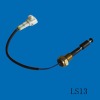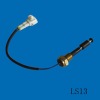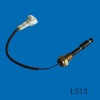- Sensors[10]
- Level Measuring Instruments[10]
- Flow Switches[2]
- Motorcycle Fuel System[2]
- Flow Sensors[5]
- Flow Meters[1]
- Other Switches[2]
- Door Stops[1]
- Elevator Parts[3]
- Other Door & Window Accessories[1]
- Relays[7]
- Contact Person : Mr. Li Alex
- Company Name : Misensor Tech (Shanghai) Co., Ltd.
- Tel : 86-21-60976207
- Fax : 86-21-60976212
- Address : Shanghai,Shanghai,Floor 2, Building 4, No. 25, Hangming Road, Hangtou Town, Pudong New District
- Country/Region : China
- Zip : 201316
Through-Hole Reed Sensors
Specifications
The MS13 proximity sensors are magnetically operated Reed switches for through-hole PCB mounting. The reed sensor should be mounted on a fixed surface with the actuating magnet on the moving surface. The Reed Sensor and the magnet must be fixed in a definite distance to each other. Introduction or removal of the magnetic field determines the closing and opening of the Reed Switch. 2.54 mm PCB pin spacing, available with different distances.
Features
Form A, B, C and E (Latching) available High power switches available Various case sizes available Five operate sensitivities availableApplications
Telecommunications Telephone hook switch, keyboard applications, micro switch Domestic appliances Door switch for washing machines, dishwashers, microwave / baking ovens, refrigerators etc. Limit switch for low-power signals Garage door controls, lever hoists, conveyors Lifts / elevators Position indicatorsHow Reed Sensors are used with a Permanent Magnet
Using Reed Sensors in a sensing environment, one generally uses a magnet for actuation. It is important to understand this interaction clearly for proper sensor functioning. Sensors may operate in a normally open mode, a normally closed mode or a latching mode.
In the normally open mode, when a magnet is brought toward the Reed Sensor (or vice versa) the reed blades will close. When the magnet is withdrawn the reed blades will open. With the normally closed sensor, bringing a magnet to the Reed Sensor the reed blades will open, and withdrawing the magnet, the reed blades will re-close. In a latching mode the reed blades may be in either an open or closed state.
When a magnet is brought close to the Reed Sensor the contacts will change their state. If they were initially open, the contacts will close. Withdrawing the magnet the contacts will remain closed. When the magnet is again brought close to the Reed Sensor, with a changed magnetic polarity, the contacts will now open. Withdrawing the magnet the contacts will remain open. Again, reversing the magnetic polarity, and bringing the magnet again close to the Reed Sensor the contacts will again close and remain closed when the magnet is withdrawn. In this manner, one has a latching sensor or a bi-stable state sensor.
Reed Sensor Mounting
Multiple options are available when mounting a Reed Sensor. However, the sensor must not be mounted on or near any ferromagnetic material. This is because magnetic flux lines travel better in ferromagnetic material, thus causing a shunting effect on the magnetic field. Magnetic components must also be considered: inductors, transformers, toroids, for example, as they will influence the magnetic sensing circuit.
Reed Sensors can be supplied with a variety of mounting possibilities: simple slots for screw hole mounting; double-back adhesive tape; they can be screwed simply into panels; they can be PCB mountable with pins; they can have surface mount 'J' or 'gull' leads for mounting on SMT boards. Other variations exist so that all application mounting possibilities may be met.
Reed Sensors vs. Hall Effect Sensors
Since their introduction several years ago, the Hall effect sensor has captured the imagination of design engineers. Generally, it was thought that if it is in solid state that it is a more reliable approach, particularly when comparing it to electromechanical devices. However, several remarkably interesting advantages are observed when comparing the reed sensor technology to the Hall effect technology.
But first, let us take a closer look at the reed sensor technology. The key component in the reed sensor is the reed switch, invented by Western Electric back in the 1940's. The other major component is the magnet or electro-magnet used to open or close the reed switch. Over the last seventy years the reed switch has undergone several improvements, making it more reliable, improving its quality and reducing its cost. Because of these dramatic improvements of reed switches, they have become the design-in choice in several critical applications where quality, reliability and safety are paramount.
However, when comparing the reed sensor over a Hall effect sensor we see several advantages:1. Cost: Generally the cost of the Hall effect device is low, but it requires power and circuitry to operate. Also, its signal output is so low it often times requires amplification circuitry as well. The net result, the Hall effect sensor can be considerably more expensive than the reed sensor.
2. The reed switch has superior isolation from input to output and across the switch up to 1015 Ohms. This reduces leakage currents to fempto amps (10-15 amps) levels. On the other hand, Hall effect devices have sub-micro amp leakage levels. In medical electronic devices inserted into the human body as probes (invasive use) or pacemakers it’s very important not to have any leakage current near the heart, where micro-amp and sub-micro amp currents can alter the heart’s key electrical activity.
3. The reed is hermetically sealed and can therefore operate in almost any environment.
4. The reed has very low on resistance typically as low as 50 milli ohms, whereas the Hall effect can be in the hundreds of ohms.
5. The reed can directly switch a host of load ranging from nano volts to kilovolts, fempto amps to Amps, and DC to 6 GHz. The Hall effect devices have very limited ranges of outputs.
6. The reed sensor has a large range of magnetic sensitivities to offer.
7. Reed sensors are not susceptible to E.D.I., where electrostatic discharge may often times severely damage the Hall effect device.
8. Reed sensors are capable of withstanding much higher voltages (miniature sizes are rated up to 1000 Volts). Hall effect devises need external circuitry for ratings as high as 100 Volts.
9. The reeds are capable of switching a variety of loads, where the Hall effect sensor delivers only smaller voltages and currents.
10. The reed sensor is typically tested to withstand a three-foot drop test, which is comparable to the Hall effect sensor.
11. Because the reed sensor has no wearing parts, low level loads (<5V @ 10 mA and below), will operate satisfactorily well into the billions of operations. This rivals semiconductor MTBF figures.
12. The reed sensor is unaffected by the thermal environment, and is typically operated from -650C to +1500C with no special additions, modifications or costs. The Hall effect sensors have a limited operational range.
There are many very good applications of reed products. Selection of the proper reed in the proper application, often time is critical. Some reed sensor companies are excellent at designing in reeds in critical applications where quality, reliability and safety are paramount. “Misensor, your sensing solution”, Misensor can solve your switching and sensing problems.
Through-Hole Reed Sensors










